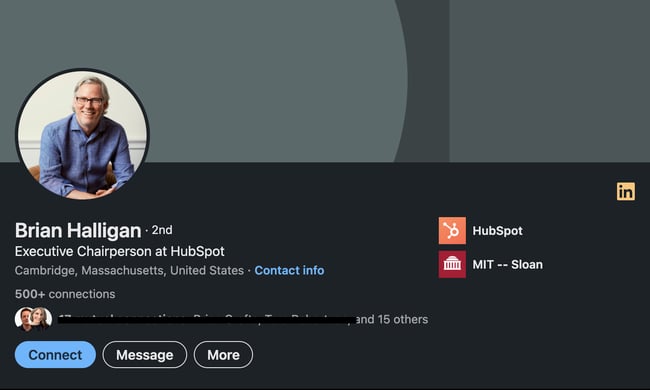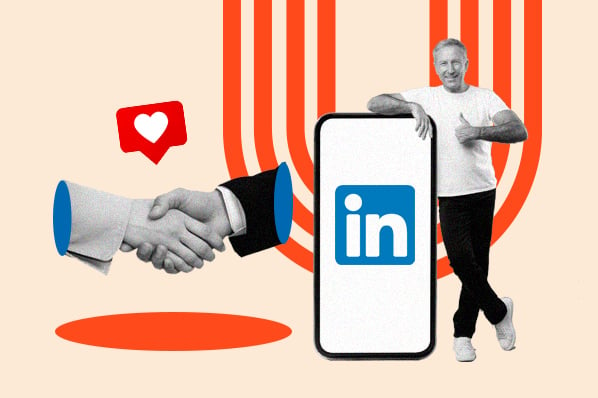You've just found the perfect role and you're ecstatic. All that's left to do is apply, but you're dreading the black hole that is the applicant tracking system. If only you had a way to get ahead in the process…
If only you had an In with a decision-maker — a recruiter…
LinkedIn's InMail tool is the perfect way to tactfully stand out to recruiters and hiring managers in your job search and build your network along the way.
With the open rate for InMail 166% higher, it's clear that people are more likely to open an InMail than a traditional email. So if you're going to reach out, InMail might be the way to go.
Download 37 Tips for Social Selling on LinkedIn
This article will teach you how to send InMail on LinkedIn and give you 10 LinkedIn tried-and-true InMail tips to follow in your messages. We’ve also curated the best LinkedIn InMail templates for four of the most in-demand jobs in 2022.
What is LinkedIn InMail?
InMail is a premium LinkedIn feature that allows you to message other users who aren't in your network. Depending on your plan, you get between three and thirty InMail credits per month.
With InMail, you'll have the ability to connect with recruiters and hiring managers on LinkedIn. But before you click away from this article, let's stop and think about whether it's a good idea to send an InMail to a recruiter.
Should I send InMail to a recruiter?
The answer is Yes! It's a great idea to send InMail to a recruiter for a job you've already applied for. However, you'll want to keep in mind a few points so that you make the most of the recruiter's time and your precious InMail credits.
Eddiana Rosen, Technical Recruiter at Google, shares some valuable insights about how to contact a recruiter regarding a job opening.
She says, "If you are looking for a job in sales, marketing, finance, etc. You might want to stay away from a recruiter that clearly states they are recruiting for UX Designers.
WHY? because they most likely do not have visibility over any other pipeline other than the roles they are recruiting for."

Rosen's advice is the best practice when it comes to sending InMail to recruiters. Make sure the recruiter you're messaging is hiring for the role you applied for. And, more importantly, make sure you've already applied for the role before reaching out so that the recruiter can give you feedback about how your resume measures up against the requirements of the job.
Here's how to send a message with InMail.
How to Send InMail on LinkedIn
- Find the LinkedIn user you want to contact.
- Go to their profile.
- Click the 'Message' button underneath their headshot and headline.
- Write your InMail message.
- Customize every InMail message you send.
1. Find the LinkedIn user you want to contact.
Use the search tool in the top left-hand corner of the page to search for the person you'd like to reach.
2. Go to their profile.
Once your search is complete, click on the user’s name and navigate to their profile page.
3. Click the "Message" button underneath their headshot and headline.

If you don't have a Premium, Recruiter, or Sales Navigator plan, clicking this button will prompt you to upgrade.
4. Write your InMail message.
The InMail message is a conversation starter. Keep your message short and to the point, use a conversational tone, and tell them what prompted you to reach out.
5. Customize every InMail message you send.
When you reach out to someone for the first time on InMail, make sure you do a bit of recon beforehand so you can write a customized message they will actually respond to. For example, make sure you spell their name correctly, acknowledge that you're familiar with their work or industry, and start a natural conversation from there. The nine components of an effective LinkedIn message can help you.
LinkedIn InMail Samples and Templates
LinkedIn lets you create up to 500 InMail templates (and even share them with your coworkers) if you operate a Recruiter account. Everyone else can still use templates — you just need to save them somewhere that's easily accessible and then copy and paste them into the InMail composer box.
InMail Examples and Template for the Recruiter and Hiring Manager
Template #1:
Are you trying to bring new talent on board? Whether you're a dedicated recruiter, the hiring manager, or an entrepreneur, make your InMail customized and compelling.

What makes this InMail template effective:
- It's enthusiastic and human-sounding.
- It comes from the CEO, which naturally makes me sit up and pay attention.
- It makes the company seem like a great place to work and drops some impressive growth stats.
- It uses a soft close ("Let me know what time works for you"), assuming I'm interested.
- It's highly scalable — note this InMail could work for any content marketer.
Try this template:
Hi [candidate name],
I came across your profile while looking for successful [insert job title, e.g., "SaaS salespeople"] who are clearly [adjective 1 and adjective 2, such as "driven and tech-savvy."] You fit the bill. I think you could be a great fit for a [function, like "sales"] role at [company] — we're [growing fast, just raised $X in funding, currently #1 in Y space, etc.]
I'd love to chat with you for a few minutes about the opportunity. Let me know when you're free.
Thanks,
[Your name]

This recruiting InMail is also a great example. It's incredibly concise and manages to get the point across in a few lines. Rather than describing the job or mentioning any specifics, this message is intended to determine my interest.
For the same effect, try this template:
"[Candidate name] — Impressive background and profile. We need a stand-out [job title] like you [to help with X objective, on Y team]; is that something you'd be interested in discussing? Let me know if you're open to a call.
[Your name]"
Job Inquiry Example and Template
72% of recruiters are active on LinkedIn, so it makes plenty of sense to reach out to them.
When you're applying for a job, a good "backdoor" strategy is finding someone with a similar or identical role on that team and reaching out for advice.
Not only will they often offer to refer you — which gives you a huge boost in the application process — you can get inside information on the culture, requirements, and company.
Template #2:
Here's the message I sent Lindsay Kolowich when I was applying to the HubSpot Sales Blog writing position (it's an email, not an InMail, but could just have easily been sent via LinkedIn):

What makes this InMail template effective:
- I connected with Lindsay over Twitter first, so she was expecting my email.
- I show I'm a fan of her work.
- I make it easy to answer my questions.
Try this template:
"Hi [employee name],
"It's great to connect with someone else who's written for TechCrunch."
I'm interested in [company's] open [job title] role, and since you [have been at company for X years, work on the Y team, are doing great work there], I'd love to get your thoughts.
Would you be open to answering 3-5 quick questions? It would be so appreciated.
Thank you,
[Your name]"
Some candidates also directly reach out to the hiring manager. Beware, career expert Alison Green warns this method can actually backfire. Put yourself in the hiring manager's shoes: You're incredibly busy, and you're getting a request for "more information" that's a thinly veiled attempt to differentiate yourself or "jump the line."
The job description almost always has enough information, and applying is a strong indication of interest — so there's no need to reach out beforehand or simultaneously.
Connecting InMail Example and Template
Template #3:
You likely come across people all the time who would be incredibly handy to have in your network. If you want them to respond, be helpful, friendly, and complimentary.

What makes this InMail template effective:
- It's flattering.
- It offers a fantastic reason to connect — I'll gain potential sources for content.
- It's cheery, easy to read, and short.
Try this template:
"Hi [name],
I'm [a big fan of your work, impressed with your career, an enthusiastic listener of your podcast, etc.] and would love to connect on LinkedIn. If you ever need help with [X specialty] or [Y area of expertise], I'd be glad to offer a hand — or introduce you to someone who can.
Cheers,
[Your name]"
Press Outreach Example and Template
Template #4:
Getting bloggers and journalists to write about your startup, product, or experience is no small feat. However, you'll have the best odds if you briefly describe why this is a print-worthy story.

This InMail caught my attention because:
- It references details from my profile.
- It demonstrates the sender did research.
- It's relevant.
- It ends with a short, simple question.
Try this template:
"Hey [writer name],
I've read and really enjoyed several of your articles on [topic] — especially like how you [did X]. (I also noticed [detail from profile], which is pretty cool.) Since you have the [topic] beat, I thought you might be interested in hearing about [insert pitch here]. I think [publication's] readers would find this story intriguing because:
- Reason #1
- Reason #2
What do you think?
[Your name]"
LinkedIn InMail Tips
- Be direct.
- Make a small request.
- Spark their interest.
- Be natural.
- Explain why you're reaching out.
- Make it about them.
- Don't put more work on them.
- Customize your templates.
- Mention the next steps.
- Keep next steps vague.
1. Be direct.
LinkedIn says simple, straightforward messages get more responses. Instead of sending a long message with several paragraphs, try pairing your outreach to two or three sentences and include only essential information.
2. Make a small request.
Asking for too much too soon will scare people off. It's tempting to ask a recruiter to "check the status" of your application, but oftentimes this information can be reviewed in your applicant portal without additional help.
To avoid wasting an InMail message, you might ask a question about the company culture or the timeline for the hiring process — in other words — information that you can't find on your own.
3. Spark their interest.
It's a good idea to try to connect with the recruiter or follow them before sending InMail. This way, you can see the content they post and interact with them. You could spark their interest by sending an InMail about a recent post they wrote to dive deeper into the topic.
4. Be natural.
I know it's cliché, but be yourself. It's no secret that a power dynamic exists between yourself as the job hunter and the recruiter as the gatekeeper, but resist the urge to be overly formal.
Writing your message the same way you would to a coworker you're familiar with would be an indicator that you're confident and will add your unique personality to the company's culture.
5. Explain why you're reaching out.
Once you find the right recruiter, think about what you want to say. Although it's probably along the lines of "I'm a perfect fit for the job and available to interview ASAP!" take a moment to explain exactly why you're reaching out.
Are you looking for details about the team? Perhaps you want to know about a recent re-org that was published in the news? Think critically about the outcome you're expecting from your message and articulate it clearly. The recruiter will thank you for the thoughtful message.
6. Make it about them.
Rather than focusing on your goal of landing the job, discuss how you can potentially help the recruiter fill other roles. If you notice that they have several jobs open, but you only applied to one, offer to set up an intro with a friend who's interested in one of the openings.
After all, recruiters are in the business of sourcing and hiring talent. Your InMail message with a qualified candidate recommendation will stand out and place you on their radar. Plus, your friend has an In to a new job, too. Win, win, win!
7. Don't put more work on them.
Avoid asking the recruiter to review anything in your InMail. Linking to a job description or your product page may come across as presumptuous and could hurt your chances of receiving a response.
An alternative to this is to limit the amount of work you're asking the recruiter to do. Ask simple questions that don't require research. Personal experiences, company culture information, and recent company changes are all reasonable topics to include in your InMail.
8. Customize your templates.
LinkedIn templates are a great time-saving tool; however, relying on them too much is counter-productive. Think about how much InMail a recruiter gets each day. Now consider how much of those messages are templates that can be found with a quick search for "InMail templates" (including those we share in this post!)
In order to stand out, you should customize any template you use to fit your style and your specific situation.
9. Mention the next steps.
Using terms like "connect," "talk," "chat," "follow up," and "discuss" all positively boost the probability of a reply, so include a line about having a conversation if that is what you're looking for.
10. Keep the next steps vague.
Typically, HubSpot advises making your call-to-action as specific as possible, e.g., "Are you free at 2 p.m. tomorrow for a 15-minute call?" But LinkedIn's data shows specificity is actually bad for your response rates. So before you offer a date and time, mention a salary range, or provide your email address, gauge your recipient's interest. Then, if they bite, delve into the nitty-gritty.
Send InMail that recruiters want to see.
Recruiters are the gatekeepers between candidates and hiring managers, and they're on your side cheering you on to the first day at your dream company. Sending a LinkedIn InMail message can better your chances of standing out from the crowd, but only if you're thoughtful in your delivery. Use this guide and templates to write your InMail message to a recruiter and land your dream job.
Editor's note: This post was originally published in June 2019 and has been updated for comprehensiveness.Social Selling on LinkedIn



![Here’s how to write a professional LinkedIn headline to 10x your presence [+ examples]](https://53.fs1.hubspotusercontent-na1.net/hubfs/53/linkedin%20headline%20featured.webp)
![15 Best LinkedIn Summary & Bio Examples [+ How to Write Your Own]](https://53.fs1.hubspotusercontent-na1.net/hubfs/53/linkedin-summary-examples-4.jpg)



.jpg)



![LinkedIn Prospecting Messages: How to Nail One [+ Templates]](https://53.fs1.hubspotusercontent-na1.net/hubfs/53/Linkedin%20prospecting%20messages%20(1).webp)